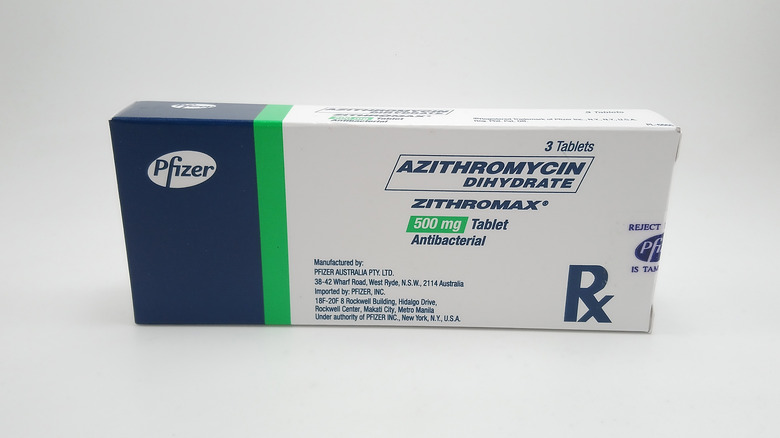What Is A Z-Pak And How Does It Work?
At one time or another, we've all gone to the doctor with a fever, cough, or congestion. In those instances, your doctor may have prescribed what is called a "Z-Pak." It's also possible that you requested the Z-Pak yourself, having taken it before.
Also known as Zithromax, or azithromycin, a Z-Pak is a five-day course of antibiotics that is typically used to treat infections such as bronchitis, pneumonia, and various lung and ear infections (via Drug Watch). According to K Health, azithromycin is also very effective against sexually transmitted diseases like chlamydia. A 2007 study published in Clinical Infectious Diseases showed that azithromycin had a 98% success rate against chlamydia.
Zithromax is usually taken once daily by mouth and can be taken with or without food (via WebMD). Ideally, it's best to space out your doses evenly, so you should make sure you set a schedule to take your Zithromax every day at the same time. You also should not stop taking it until the five-day course is fully complete.
Z-Paks are designed to fight bacteria
According to Drug Watch, Zithromax is part of a class of antibiotics called macrolides, which prevent bacteria from multiplying. As opposed to some other antibiotics, which kill off the bacteria directly, macrolides keep bacteria from producing the proteins they need to keep growing. Over time, the body's immune system, as opposed to the drug itself, kills off the remaining bacteria. It's important to note that Z-Paks only work on bacterial infections, so they are not effective against viral infections such as the common cold (via Medical News Today).
Given azithromycin's long half-life — the amount of time it takes for your body to metabolize half the medication — of around 68 hours, the drug will remain in your system and continue working for up to five days following your last dose, according to Hello Pharmacist. Because of this, you may not see your symptoms improve immediately after finishing your course of treatment. However, due to the half-life of azithromycin, you will want to wait up to five days after you have finished to see how you are feeling. If, after a few days, your symptoms haven't cleared up, you should contact your doctor.
Beware of possible Z-Pak side effects
According to the Mayo Clinic, it's a good idea to weigh any potential risks of a Z-Pak against its ultimate benefits. You should consult with your doctor and let him or her know of any allergies you may have, as well as what medications you are already taking. Certain medications do not interact well with Zithromax and could increase the risk of an abnormal heart rhythm known as "QT prolongation" (via MedBroadcast).
You may be at greater risk for QT prolongation if:
- You are female
- You are older than 65
- You have a family history of cardiac issues
- You have a personal history of heart disease
- You have had a stroke
- You have low potassium, magnesium, or calcium
- You have nutritional deficiencies
- You have diabetes
One of the most common side effects of Zithromax is diarrhea, according to GoodRx. In clinical trials conducted by the Food and Drug Administration, up to 5% of patients taking Zithromax reported diarrhea as a side effect. If you have loose stools while taking a Z-Pak, you should change your diet and avoid greasy or high-fiber foods, while also staying hydrated regularly.
The Mayo Clinic also reports that nausea, vomiting, and stomach pain are possible side effects of Z-Pak usage. If these symptoms continue unabated, or if you experience more serious reactions such as dark urine, bloody stools, or vision or hearing changes, you need to contact your doctor right away.
Please consult the package insert or your doctor or pharmacist for more complete information.



